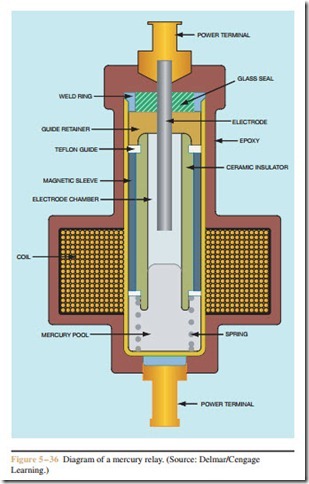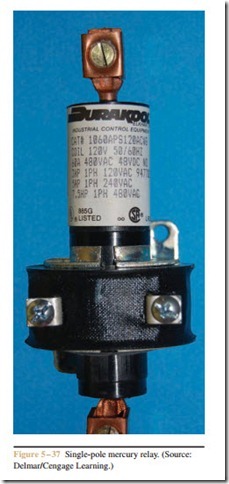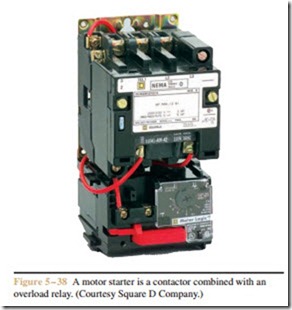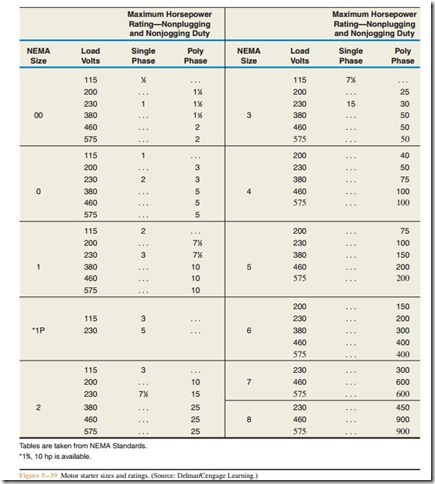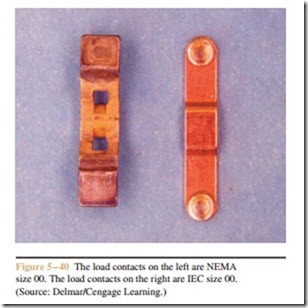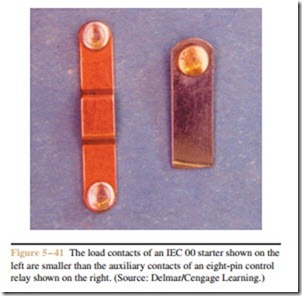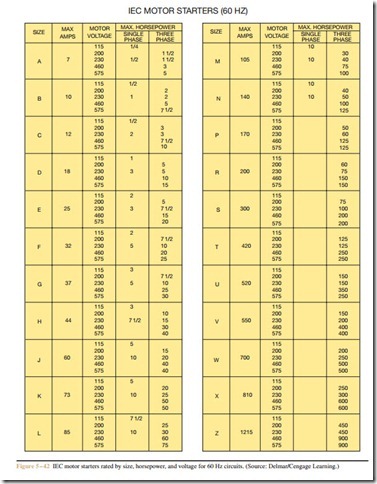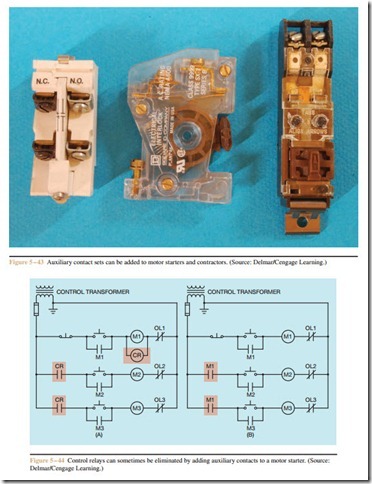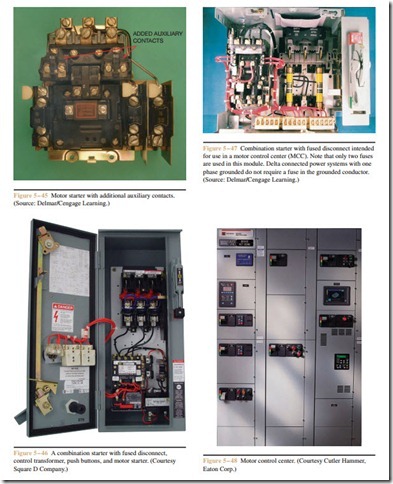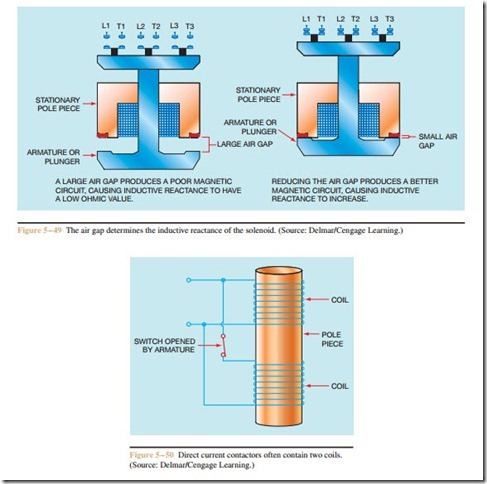Motor Starters
Motor starters are contactors with the addition of an overload relay (Figure 5 – 38). Since they are in- tended to control the operation of motors, motor starters are rated in horsepower. Magnetic motor starters are available in different sizes. The size of starter required is determined by the horsepower and voltage of the motor it is intended to control. There are two standards that are used to determine the size of starter needed: NEMA and IEC. Figure 5 – 39 shows the NEMA size starters needed for normal starting duty. The capacity of the starter is determined by the size of its load or power contacts and the wire cross-sectional area that can be connected to the starter. The size of the load contacts is reduced when the voltage is doubled, because the current is halved for the same power rating (P = E X I ).
The number of poles refers to the load contacts and does not include the number of control or auxiliary contacts. Three-pole starters are used to control three- phase motors, and two-pole starters are used for single- phase motors.
NEMA is the acronym for National Electrical Manufacturers Association. Likewise, IEC is the acronym for International Electrotechnical Commis- sion. The IEC establishes standards and ratings for dif- ferent types of equipment just as NEMA does. The IEC, however, is more widely used throughout Europe than in the United States. Many equipment manufac- turers are now beginning to specify IEC standards for their products produced in the United States, also. The main reason is that much of the equipment produced in the United States is also marketed in Europe. Many European companies will not purchase equipment that is not designed with IEC standard equipment.
Although the IEC uses some of the same ratings as similar NEMA rated equipment, there is often a vast difference in the physical characteristics of the two. Two sets of load contacts are shown in Figure 5 – 40. The load contacts on the left are employed in a NEMA rated 00 motor starter. The load contacts on the right are used in an equivalent IEC rated 00 motor starter.
tion with motor starter coil M1. The two normally open CR contacts prevent motors #2 and #3 from starting until motor #1 is running. In the circuit shown in Fig- ure 5 – 44B, it is assumed that two auxiliary contacts have been added to motor starter M1. The two new aux- iliary contacts can replace the two normally open CR contacts, eliminating the need for control relay CR. A motor starter with additional auxiliary contacts is shown in Figure 5 – 45.
Notice that the surface area of the NEMA rated con- tacts is much larger than the IEC rated contacts. This permits the NEMA rated starter to control a much higher current than the IEC starter. In fact, the IEC starter contacts rated equivalent to NEMA 00 contacts are smaller than the contacts of a small eight-pin control relay (Figure 5 – 41). Due to the size difference in contacts between NEMA and IEC rated starters, many engineers and designers of control systems specify an increase of one to two sizes for IEC rated equipment than would be necessary for NEMA rated equipment. A table of the ratings for IEC starters is shown in Figure 5 – 42.
Although motor starters basically consist of a contactor and overload relay mounted together, most contain auxiliary contacts. Many manufacturers make auxiliary contacts that can be added to a starter or contactor (Figure 5 – 43). Adding auxiliary contacts can of- ten reduce the need for control relays to perform part of the circuit logic. In the circuit shown in Figure 5 – 44, motor #1 must be started before motors #2 or #3. This is accomplished by placing normally open contacts in series with starter coils M2 and M3. In the circuit shown in Figure 5 – 44A, the coil of a control relay has been connected in parallel with motor starter coil M1. In this way, control relay CR will operate in conjunc-
Motor Control Centers
Motor starters are often grouped with other devices such as circuit breakers, fuses, disconnects, and control transformers. This set of equipment is referred to as a combination starter. These components are often con- tained inside one enclosure (Figure 5 – 46).
Motor control centers employ the use of combina- tion starters mounted in special enclosures designed to plug into central buss bars that supply power for several motors. The enclosure for this type of combination starter is often referred to as a module, cubicle, or can, Figure 5 – 47. They are designed to be inserted into a motor control center (MCC), as shown in Figure 5 – 48. Connection to individual modules is generally made with terminal strips located inside the module. Most manufacturers provide some means of removing the entire terminal strip without having to remove each in- dividual wire. If a starter should fail, this permits rapid installation of a new starter. The defective starter can then be serviced at a later time.
CAUTION:
By necessity, motor control centers have very low impedance and can produce extremely large fault currents. It is estimated that the typical MCC can de- liver enough energy in an arc-fault condition to kill a person thirty feet away. For this reason, many indus- tries now require electricians to wear full protection (flame retardant clothing, face shield, ear plugs, and hard hat) when opening the door on a combination starter or energizing the unit. When energizing the starter, always stand to the side of the unit and not directly in front of it. In a direct short condition, it
Current Requirements
When the coil of an alternating current relay or contactor is energized, it will require more current to pull the armature in than to hold it in. The reason for this is the change of inductive reactance caused by the air gap (Figure 5 – 49). When the relay is turned off, a large air gap exists between the metal of the stationary pole piece and the armature. This air gap causes a poor magnetic circuit, and the inductive reactance (XL) has a low ohmic value. Although the wire used to make the coil does have some resistance, the main current limit- ing factor of an inductor is inductive reactance. After the coil is energized and the armature makes contact with the stationary pole piece, there is a very small air gap between the armature and pole piece. This small air gap permits a better magnetic circuit, which increases the inductive reactance, causing the current to decrease. If dirt or some other foreign matter should prevent the armature from making a seal with the stationary pole piece, the coil current will remain higher than normal, which can cause overheating and eventual coil burnout.
Direct current relays and contactors depend on the resistance of the wire used to construct the coil to limit current flow. For this reason, the coils of DC relays and contactors will exhibit a higher resistance than coils of AC relays. Large direct current contactors are often equipped with two coils instead of one (Figure 5 – 50). When the contactor is energized, the coils are connected in parallel to produce a strong magnetic field in the pole piece. A strong field is required to provide the attraction needed to attract the armature. Once the armature has been attracted, a much weaker magnetic field can hold the armature in place. When the armature closes, a switch disconnects one of the coils, reducing the current to the contactor.
Review Questions
1. Explain the difference between clapper type contacts and bridge type contacts.
2. What is the advantage of bridge type contacts over clapper type contacts?
3. Explain the difference between auxiliary contacts and load contacts.
4. What type of electronic device is used to connect the load to the line in a solid state relay used to control an alternating current load?
5. What is optoisolation and what is its main advantage?
6. What pin numbers are connected to the coil of an eight-pin control relay?
7. An eleven-pin control relay contains three sets of single-pole double-throw contacts. List the pin numbers by pairs that can be used as normally open contacts.
8. What is the purpose of the shading coil?
9. Refer to the circuit shown in Figure 5 – 29. Is the thermostat contact normally open, normally closed, normally closed held open, or normally open held closed?
10. What is the difference between a motor starter and a contactor?
11. A 150-horsepower motor is to be installed on a 480 volt three-phase line. What is the minimum size NEMA starter that should be used for this installation?
12. What is the minimum size IEC starter rated for the motor described in question 11?
13. When energizing or de-energizing a combination starter, what safety precaution should always be taken?
14. What is the purpose of “coil clearing contacts”?
15. Refer to the circuit shown in Figure 5 – 29. In this circuit, contactor HR is equipped with five contacts. Three are load contacts and two are auxiliary contacts. From looking at the schematic diagram, how is it possible to identify which contacts are the load contacts and which are the auxiliary contacts?

